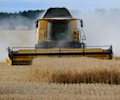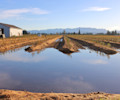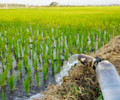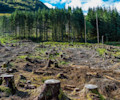Interest in regenerative agriculture is surging among investors and corporates. FAIRR’s research in 2023 found that 50 of 79 major agribusinesses, representing US$3 trillion in revenue, reference regenerative agriculture in their sustainability disclosures.
Yet, critical gaps are preventing a large-scale uptake of regenerative agricultural practices.
The sector still lacks consistent definitions, clear metrics to track outcomes, and – crucially – viable incentives to support farmers in a way that generates system-wide change.
One of the biggest challenges is a disconnect across the agri-food value chain. Discussions about regenerative agriculture often take place in boardrooms, far removed from the realities of the farm.
For investors, whose capital is crucial to accelerating this transition, understanding what regenerative agriculture looks like in practice, and the operational and financial realities behind it, is essential to supporting solutions that generate sustainable financial returns and environmental benefits.
To bridge this gap, FAIRR partnered with the European Alliance for Regenerative Agriculture (EARA) to bring 20 investors and 10 farmers to Dunthrop Farm in the Cotswolds, England.
Led by third-generation farmer Timothy Coates, the visit combined a guided farm tour with a seasonal farm-to-table lunch and an agri-food knowledge sharing session.
The event aimed to showcase the on-ground realities of regenerative agriculture and to unpack its technical, environmental, and economic considerations, creating a shared understanding between capital providers and practitioners that can help turn boardroom ambition and corporate commitments into real-world transformation.
This Insight piece highlights some of the key takeaways from the farmer-investor dialogues that took place.
1. A One Health approach is fundamental to farming
Farmers recognise the links between environmental and human health, emphasising the connection between maintaining the health of the soil, the food they grow, and the health of people consuming that food.
This mirrors the One Health approach advocated by FAIRR and other industry experts, where the health of humans, animals and the wider ecosystem is considered holistically and made central to decision-making.
Participants indicated widespread support for regenerative practices that can improve soil health, such as using bio-based fertilisers and cover crops, rotating crops and using silvopasture systems.
These practices can all deliver a range of climate and nature benefits, while also ensuring net-returns for farmers (and investors). FAIRR has assessed the benefits of these solutions over their technology-based counterparts in its report, Climate and Nature-based Interventions in Livestock.
2. Nature-positive farming is difficult to implement in practice
Nature-positive refers to the recognition that governments, businesses and society at large need to move beyond minimising harm to delivering real and measurable improvements to nature, as highlighted by the International Union for Conservation of Nature and Natural Resources.
But while the term is starting to be used in industry discussions and research, implementing it in a farming context is difficult, with one participant arguing it means farms giving back more than they produce.
At Dunthrop Farm, for example, wheat is produced through a regenerative system that restores natural capital while maintaining yields, using hedgerows and trees, reducing synthetic inputs, and monitoring long-term soil health to improve the resilience of the farmland and soils.
For investors, this highlights the potential and challenge of regenerative agriculture. Regenerative models can deliver yields as well as measurable gains in climate mitigation, soil health, and biodiversity, ensuring that more is put into the system than is taken out. However, not every farm or landscape can achieve similar results. Ambitions need to be paired with realistic expectations and mechanisms to make nature-positive farming viable and scalable.
3. Regenerative practices can improve resilience, but also come with social risks
Event participants recognised that adopting regenerative agriculture practices makes farms more resilient. For example, reintegrating grasslands into diverse livestock and crop systems rebuild the organic matter in soil and can improve a farm’s capacity to hold water, reducing its vulnerability to flood and drought cycles.
A study by Aquanomics estimates that floods, droughts and storms could cause almost US$5.6 trillion in GDP losses for eight countries alone, while FAIRR’s Climate Risk Tool estimates that protein producers could face cost increases of nearly 40% by 2030 and nearly 60% by 2050 if global temperatures rise above two degrees.
Conversely, efforts to improve flood, drought and climate resilience more broadly can have a positive impact: the World Resources Institute found that cumulatively, investments in 320 adaptation and resilience projects including agriculture are expected to generate US$1.4 trillion in benefits over 10 years, with an average return of 27%.
However, event participants also highlighted that the regenerative agriculture transitioning can be socially isolating, because:
If farmers making that transition are in the minority, they risk being undermined by neighbouring peers that continue to employ intensive or non-regenerative practices, reducing the biodiversity- or water related benefits generated by more sustainable approaches;
that transition can be seen as deviating from broader farming community norms, with farmers at risk of being ostracised.
Furthermore, the transition required to implement a regenerative agricultural system is characterised by uncertain short-term returns - social pushback can heighten the risk of farmers reverting to the status quo.
According to McKinsey, ~70% of farmers are willing to try a new practice or technology if most of their peers have tried it successfully, highlighting the importance of building trust throughout farming communities to preserve longer-term value and returns.
4. Effectiveness of regenerative agriculture is context specific
Farmers stressed that the use and effectiveness of regenerative agriculture is context- and site-specific. For example, pasture-based systems on steep slopes may not be able to implement practices such as cover crops or crop rotations, therefore limiting how applicable the full range of regenerative practices are; while farms that have wetter soils may find it challenging to practice certain regenerative practices like no tillage due to soil compaction.
As such, channelling financial support towards regenerative agricultural practices without understanding such nuances is likely to be counterintuitive, making it crucial for investors and policymakers to assess their feasibility and trade-offs in different geographies, rather than assuming uniform outcomes.
Indeed, many policymakers designing incentives and subsidy schemes lack a practical understanding of on-the-ground farming. This disconnect risks driving policies that:
reward practices that fall short of delivering real environmental benefits, or
incentivise sub-optimal or infeasible outcomes that are not transformational.
This also reflects FAIRR’s work on climate and nature solutions, which assessed the benefits and trade-offs of nature and technology-based solutions, using the planetary boundaries framework.
For example, anaerobic digesters can treat animal and crop waste and produce biogas, but they may also encourage intensive livestock farming and lead to a concentration of animal waste that could harm biodiversity and human health.
5. The agri-food transition requires value chain collaboration
Participants agreed that collaboration across the value chain – from farmers to corporates and investors – is needed to ensure a well-informed and well-funded regenerative transition.
Studies show that adopting regenerative practices often comes with high upfront costs, lower initial yields and long pay-back periods before benefits materialise. This represents a major barrier to farmers and landowners, and without adequate financial support and assurances, can lead to unsustainable debt burdens and severely reduced net incomes.
Investors, insurance companies and major food companies and governments can all play a role in supporting the transition, as FAIRR highlighted in an Insight piece published in July.
Conclusion
The transition to regenerative agriculture presents a compelling opportunity and a complex challenge.
As the FAIRR-EARA farm visit underscores, unlocking the full potential of regenerative agriculture requires more than capital – it demands deep engagement with farmers, approaches that capture the nuance of context and location, and cross-sector collaboration to ensure adequate financial support for farmers on the ground.
For investors, this means moving beyond sustainability rhetoric to actively shaping solutions that deliver long-term value: resilient supply chains, measurable environmental gains, and future-proofed portfolios.
Regenerative agriculture isn’t simply a farming model – it is an investment in the health of ecosystems, economies, and communities.
FAIRR insights are written by FAIRR team members and occasionally co-authored with guest contributors. The authors write in their individual capacity and do not necessarily represent the FAIRR view.











